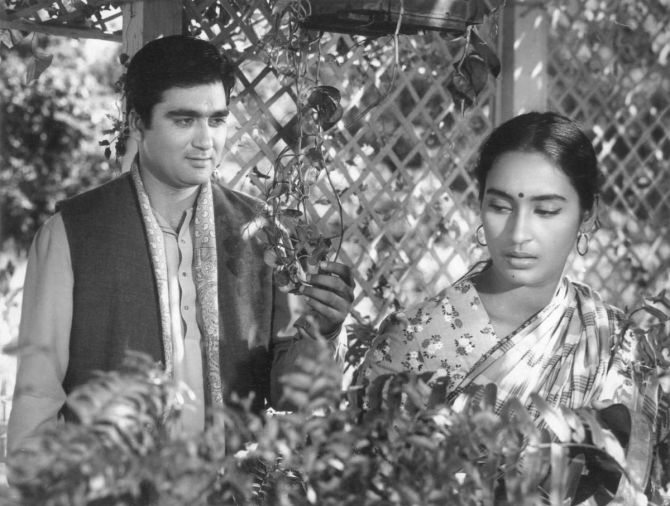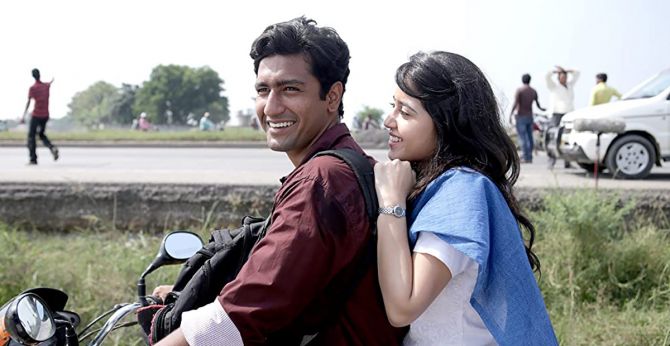 | « Back to article | Print this article |
As we celebrate Dr Babasaheb Ambedkar's birthday on April 14, Subhash K Jha picks five fine films based on inequality and the caste system.
Sujata, 1959

Inspired directly by Dr Ambedkar's treatise on the abolishment of the caste system, Sujata is a haunting, relevant, meditation on blood ties and social inequality.
Nutan won her her Filmfare award as the socio-economically backward orphan, adopted by an upper class couple, played by Tarun Bose and Sulochana.
The mother can never bring herself to love Sujata as much as her own biological daughter Rama.
When Sujata falls in love with a Brahmin boy, played by Sunil Dutt, all hell breaks loose.
This delicate film is best remembered for Nutan's nuanced act and could address Dr Ambedkar's thoughts and feelings directly.
The sequence where Sujata sobs under Gandhiji's statue in the pouring rain remains emblematic of the inequality that still rules our socio-political conscience.
Sooraj Barjatya later made a fluffy version of Sujata, Vivah, starring Shahid Kapoor and Amrita Rao.
Bandit Queen, 1994

Shekhar Kapur's Bandit Queen remains a gut-wrenching experience 27 years after it released.
Brutal in its critique of upper caste arrogance, unsparing in its contempt for brahminical superiority, and starkly candid in using rape as a tool of oppression and disempowerment, this film comes from a place of great anger.
Shekhar admits he was seething in rage when he made Bandit Queen and his anger remains undiminished as he finds the privileged class in India flaunting its wealth in the face of the socio-economically backward classes.
Ankur, 1974

At a time when brutal oppression is a way of life, when a girl gets molested on the street by a mob while civilised society watches in mute submission, it's befitting to remember the celebrated finale in Ankur when -- after watching a mute-and-deaf peasant being whipped by a zamindar's son -- a little boy picks up a stone and hurls it at the glass windowpane of the oppressor.
It was a decisive moment when Hindi cinema resolved to turn revolutionary.
Shabana Azmi, Sadhu Meher and Anant Nag, all new to the movie camera, were brought in to play out a triangular drama where the peasantry gets a sensitive, heartbreaking treatment.
Shyam Benegal's directorial debut remains his most searing indictment of oppression, set within an extended feudal system in Andhra Pradesh where the zamindari system is gone.
But though it is abolished, the feudal mindset lives on.
Carrying forward the tradition of cinema set in the poverty of the Indian heartland, Ankur took forward the feudal fable of Satyajit Ray's Pather Panchali and Bimal Roy's Do Bigha Zameen though the language used to convey the sharp cutting contours of socio-economic oppression in Ankur are far removed from the way Ray and Roy envisaged it.
Outwardly, Ankur is an immensely tranquil film. The green stretches of land are barely able to hide the vast acres of pain and angst of a society built on inequality and injustice.
Nothing has changed over the years.
The seedling (Ankur) of social protest is still to grow into a powerful collective protest. Equality on every level is still a dream.
Masaan, 2015

Masaan is not an easy film to ingest. It sucks you into its world of characters, doomed by caste and ruined by wrong choices.
The main protagonists are played by Sanjay Mishra, Richa Chadha and Vicky Kaushal, actors whose deep link with the middle class helps them manoeuvre their characters in and out of the trauma and anguish that the under-privileged classes are subjected to.
The young lovers, played with an unspoilt naturalness by Vicky Kaushal and Shweta Tripathi, build an atmosphere of lulling gentleness around the plot that shatters to bits as the script moves to a zone of unexpected explosion.
Compelling and devastating, Masaan marked Neeraj Ghaywan's remarkable directorial debut.
I wonder why he has not made another feature film since.
Sadgati, 1981

The great Satyajit Ray made only two Hindi films.
One of them is this little-seen television film, a scathing indictment of the caste system, featuring Om Puri as a backward, disempowered, labourer, who goes to a brahmin, played by Mohan Agashe, for financial help.
The exploitation of the underprivileged class has never been more starkly portrayed.
In the end, the Harijan simply collapses and dies of overwork.
Caste exploitation couldn't get any more blunt than this.
